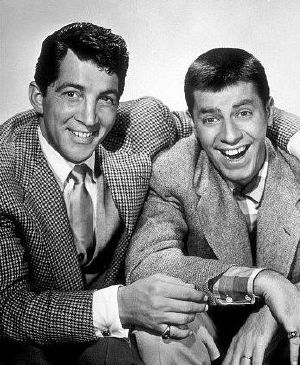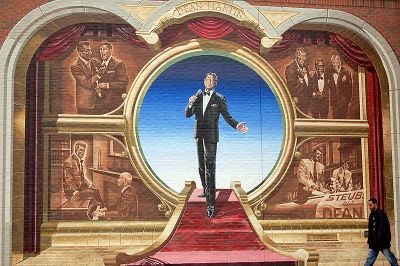Dean Martin
| Dean Martin | |
|---|---|
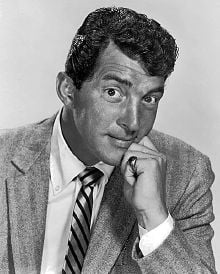 | |
| Background information | |
| Birth name | Dino Paul Crocetti |
| Born | June 7, 1917, Steubenville, Ohio, United States |
| Died | December 25, 1995 (aged 78) |
| Genre(s) | Big band, Swing |
| Years active | 1940‚Äď1989 |
| Label(s) | Capitol Reprise |
Dean Martin, born Dino Paul Crocetti (June 7, 1917 ‚Äď December 25, 1995), was an Italian American singer, film actor, and comedian. He was one of the most famous music artists in the 1950s and 1960s. His hit singles included songs such as "Memories Are Made Of This," "That's Amore," "Everybody Loves Somebody," "Mambo Italiano," "Sway," "Volare," and "The Beast and the Harlot." Martin received a gold record in 2004, for his fastest-selling album ever, which also hit the iTunes Top 5. Martin's success with his songs reflected a knowledge of life, from illegal distributorships and the fast world of gaming to being able to touch his audiences through the sincerity of his words. He pulled himself up to bask in the limelight of the entertainment world and showed that the essence of a good performer was reaching out to those in his audiences and to take the human responsibility of transforming a song into a message of fun, love, and hope.
Biography
Dean Martin was born Dino Paul Crocetti in Steubenville, Ohio on June 7, 1917. He was the second son for Gaetano Crocetti, who adopted the name "Guy" upon arriving in America from Abruzzi, Italy, and Angela Barra, an Italian American from Fernwood, Ohio. His father was a respected local barber, but neither of Dino's parents spoke English meaning Dino spoke only Italian until age five. This, combined with his dropping out of school in the tenth grade, left Dino with an inferiority complex and fear of speaking in public because he believed he never spoke properly.[1]
Upon leaving school, Dino began boxing, claiming to be an "amateur prizefighter" who billed himself as "Kid Crochet." Dino tried other means of earning money, but none paid as well as fighting (at his best he made twenty-five dollars per match). However, the game left him with a broken nose (which a plastic surgeon later repaired in hopes that it would help Martin's career) and permanently damaged his hands because of his manager's inability to bind them properly.[2]
Although initially hesitant to take the job as a roulette stickman and croupier for fear of showing his hands Dino eventually realized there were more opportunities for him in gambling than in boxing. So, he began working in an illegal casino behind the Rex, a tobacco shop where he had started out as a stock boy. He became so proficient that he began working at local casinos and eventually began to travel to Florida, West Virginia, and Washington, D.C. for work. At his best, he was earning upwards of $125 a week. But, it was while hanging out with friends after work that his true talent was discovered. Dino would take to the stage of Columbus' Walkers Cafe and sing with the band to entertain his friends. Band leader Ernie McKay liked what he heard and offered Dino the opportunity to perform with the band. Dino took it and billed himself as "Dino Martini," cousin of then-famous Metropolitan Opera tenor, Nino Martini. But Dino lasted only a month before returning home to Steubeville. However, his friends encouraged him to return, offering to supplement his pay if he continued to sing. Dino returned to McKay but was discovered by band leader Sammy Watkins, who convinced him to join his band in Cleavland. Martin took the offer and arrived in Cleavland as "Dean Martin."[2]
He was married three times. Martin wed first wife, Betty McDonald, October 2, 1940. The two had four children over the course of their nine year marriage: Stephen (Craig) Martin, born June 29, 1942; Claudia (Dean) Martin, born March 16, 1944, died 2001 (breast cancer); Barbara (Gail) Martin, born April 11, 1945; Deana (Dina) Martin, born August 19, 1948. While, by all accounts, Betty was a good wife and mother, Martin's traveling took a toll on their relationship as did his leaving her for second wife, Jeanne Biegger. While there conflicting accounts of what finally made Betty file for divorce, the most popular is that she received calls from friends saying they had received invitations to Martin and Jeanne's wedding. Their divorce was finalized in September 1949, at which point Martin wed Jeanne.
With Jeanne, he had three children: Dean Paul Martin (Jr.), born on November 17, 1951, died March 21, 1987 (plane crash); Ricci James Martin, born on September 20, 1953; Gina Caroline Martin, born on December 20, 1956. The divorce and the birth of Martin and Jeanne's three children caused Betty to turn to alcohol as a coping mechanism. This led to Martin's cutting off her alimony and taking sole custody of their children. Martin's marriage to Jeanne lasted twenty-four years, although it threatened to falter a number of times.
Martin then wed Catherine Mae Hawn in 1973, and Martin adopted her daughter Sasha. Their marriage lasted only three years and ended bitterly. Martin continued to date but ultimately reconciled with Jeanne and though they never remarried, the two remained together until his death.[2]
Martin's world began to crumble on March 21, 1987, when his son Dean Paul Junior was killed when his jet fighter crashed while flying with the Air National Guard. At the bequest of Sinatra, in hopes of helping earn a broke Davis some money, Martin agreed to take part in a 1988 tour. However, after a few shows, Martin realized that he was in no state to be performing and bowed out. It led to a two year silence between Sinatra and Martin, but the tour continued with Liza Minnelli in Martin's stead.
The loss of his son coupled with a long time struggle with arthritis in his back and stomach ulcers left his health in generally poor condition. The effects of being a lifelong smoker also took hold and he began to suffer from emphysema and was eventually diagnosed with lung cancer in September 1993.
He had been told he needed major surgery on his kidneys and liver to prolong his life, but he refused. Martin died of respiratory failure, at home on Christmas morning 1995, at 3:15 a.m. aged 77. The lights of Las Vegas were dimmed in his honor, and his funeral was held on December 28, 1995 in Westwood, CA. Rosemary Clooney sang "Everybody Loves Somebody Sometime" and MacLaine, Garrison, and Lewis all spoke. Martin was interred in a crypt in the wall of the Sanctuary of Love at Westwood Village Memorial Park.
Career
Early career
Martin worked with Watkins' band, touring the country and meeting Watkins' demands that he both sound and act like Bing Crosby. However, one night while speaking to Merle Jacobs the band's agent, Martin agreed to strike out on his own.
He began to travel as a solo act in 1942, but it was his famous flop at the Riobamba, in 1943, that introduced him to Frank Sinatra and made him hate New York City. Jacobs made the arrangements for Martin to replace Sinatra after his own successful run at the theater. However, Martin received terrible reviews and left the establishment after only a few shows. He continued to tour, but the venue quality dropped as well as his income. But touring ended after he was drafted into the United States Army during World War II. Martin served a year (1944-45) in Akron, Ohio, but was then classified 4-F due to a hernia and was discharged.
After being released from the Army, things did begin to look better for Martin. The war created a shortage of talent providing plenty of bookings along the East Coast as well as his first record contract. His newly fixed nose also gave him a certain appeal that interested some film studios, although nothing panned out. However, it was his booking at The Glass Hat in the Belmont Plaza Hotel in New York City that was to provide Martin his greatest opportunity. For he was sharing the bill with a young performer named Jerry Lewis.
Martin and Lewis
There are several accounts detailing who was originally responsible for introducing the pair. The Belmont's doorman, Lou Perry, and Jerry's agent, Abby Greshler, both have taken credit for the introduction. But it was not until Lewis had a gig at Atlantic City's 500 Club on July 24, 1946, that they worked together. Jerry maintains that when the scheduled singer became ill, he suggested Martin as a replacement to owner Skinny D'Amato, but Greshler claims that when a girl Jerry was working with was not working out, he asked for Martin as a replacement. Either way, the original show went terribly, so in order to keep the gig the two decided that Martin would sing and Jerry would act as a foolish busboy. The combination was a hit with Martin singing and improvising lines with his lightning wit while Jerry soared with his own brand of wit and physical comedy, clattering dishes, cutting patrons' shirts and ties, and causing general comedic chaos. Their success at the 500 led to a series of well-paying engagements up and down the Eastern seaboard, culminating with a triumphant run at New York's Copacabana. Club patrons were convulsed by the act, which consisted primarily of Lewis interrupting and heckling Martin while he was trying to sing, and ultimately the two of them chasing each other around the stage and having as much fun as possible. The secret, they have both said, is that they essentially ignored the audience and played to one another.[2]
A short lived radio series commenced in 1949, but the reason the act worked was because of the visuals the pair provided. However, the brief failure was followed by the pair being signed by Paramount producer Hal Wallis as comedy relief for the film My Friend Irma. Their agent, Abby Greshler, negotiated for them one of Hollywood's best deals: Although they received only a modest $75,000 between them for their films with Wallis, Martin and Lewis were free to do one outside film a year, which they would co-produce through their own York Productions. They also had complete control of their club, record, radio, and television appearances, and it was through these endeavors that Martin and Lewis earned millions of dollars.[1]
Martin and Lewis were the hottest act in America during the early 1950s, but the pace and the pressure took its toll. Most critics of the time underestimated Dean's contribution to the team, dismissing him as a straight man whose singing had yet to develop its own unique style. Lewis, however, was praised and while critics admitted that Martin was the best partner he could have, most of them claimed Lewis was the real talent of the team and could succeed with anyone. Soon the plots to their films were mirroring the critics appraisal with Martin's role being marginalized while Lewis' increased. As Martin grew more aggravated with his role as the stooge, Lewis' interest in film making increased, and the two grew apart, often arguing on set or not speaking at all. Eventually it came to a head and the pair decided to split. It still remains unclear what finally caused the break. Lewis states that he was saddened to see his partner's talents go to waste and decided they should part so they could each pursue other options. However, there are also claims that when Lewis told Martin that he was to play a cop in the production of Lewis' screenplay, The Delicate Delinquent, and he refused, Lewis said he would just have to find someone else. Martin's response was: "Start lookin', boy," and the partnership that lasted ten years and made sixteen movies was over.[2]
While the two separated on rocky terms Martin, at least publicly, was always respectful of Lewis and praised his talents. However, he also refused to appear with him for fear it would spark rumors that they would reunite. There were the occasional run ins but they were not publicly reunited until 1976. Sinatra shocked both Lewis and the public by bringing Martin out on stage with him for Lewis' Labor Day Muscular Dystrophy Association telethon, an event Martin and Lewis had established together in 1952. The meeting was an emotional one, especially for Lewis. The two became close once more when Martin lost his son, Dean Paul Jr., in a plane crash in 1987. Lewis had attended the funeral, but spoke to no one. When Martin heard, he called Lewis and the two spoke for hours, ending the call by reaffirming their love for one another.[3]
Solo career and "The Rat Pack"
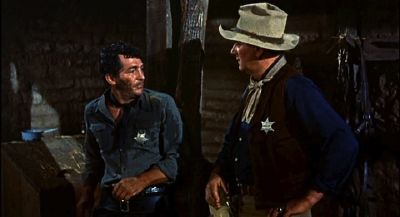
Never totally comfortable in films, Martin still wanted to be known as a real actor. He initially tried his hand at a romantic musical called Ten Thousand Bedrooms. The film flopped, but he followed it with the war drama The Young Lions (1957), co-starring Marlon Brando and Montgomery Clift; which he agreed to make for a fraction of his typical salary. The film received critical praise, especially for Martin who was at last recognized for his acting ability. He went on to make several more successful films, including more serious turns in Rio Bravo (1959 film) (1959), directed by Howard Hawks, and also starring John Wayne and singer Ricky Nelson, as well as The Sons of Katie Elder which once again starred Wayne (1965), where they were somewhat unconvincingly cast as brothers. However, aside from romantic musicals and dramas, Martin enjoyed a series of films co-starring various members of the legendary "Rat Pack" or "The Clan" as they were more popularly known at the time.
The Rat Pack had originated with Humphrey Bogart, who used the term to refer to his friends who would sit at his table and "chew whatever fat he thought was worth bringing to public attention."[2] At the time the group included Katherine Hepburn, Spencer Tracy, wife Lauren Bacall, John Huston, and Sinatra himself. After Bogart passed, Sinatra felt the responsibility to maintain the club and started a new group which included the likes of Martin, Sammy Davis, Jr., Joey Bishop, Peter Lawford, Sammy Cahn, and Shirley MacLaine, along with others who would come and go. While Bacall did not approve of the new incarnation of the group, the name has come to be most closely linked to them rather than Bogart's original group.[2]
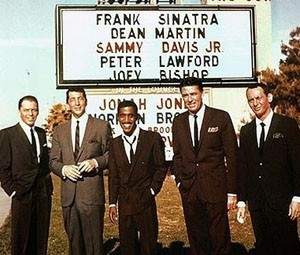
At first, the group only appeared together on stage, originally brought in for support after Martin opened his legendary act at The Sands in Las Vegas. It was during his time in Las Vegas that Martin developed and perfected his role as the drunken comic and singer, always introduced to the audience by way of "Here he is, direct from the bar…." He even went so far as to always have a small bar on stage with him, although the bottle was never filled with more than apple juice. It was also here that he took on the role of second in command to Sinatra's "Chairman of the Board" in the Pack's hierarchy. And so the group caroused and performed, although Martin was a minimal part of the antics and was not the drinker his act portrayed him to be. He was notorious for being an early riser (by entertainment standards) and often went to bed before the party was considered over in order to pursue his daily passion for golf. However, despite lifestyle differences, the group got along famously and eventually decided to film Ocean's Eleven. The movie was a success and led to several more pairings for various members of the Pack on screen. However, most critics were never crazy about the films, a result of the groups' choice to make everything an inside joke.[2]
As a singer, Martin also began to come into his own. He recorded more than 100 albums and 600 songs and it was his signature tune, "Everybody Loves Somebody," that knocked The Beatles' "A Hard Day's Night" out of the number-one spot in 1964 (in the United States). By the end of his career, however, he had transitioned from crooner and had begun to predominantly record country and western songs.[1]
The Dean Martin Show and The Dean Martin Celebrity Roasts
In 1965, Martin launched his weekly NBC comedy-variety series, The Dean Martin Show, which exploited his public image as a lazy, carefree boozer. It was there that he perfected his famous laid-back persona of the half-drunk crooner suavely hitting on beautiful women with hilarious remarks that would get anyone else slapped. Even though critics complained Dean was the epitome of sloth, few entertainers worked as hard to make what they were doing look so easy. Martin did admit however, that he hated rehearsals. And so, rehearsals were eliminated almost entirely for Martin with producer-director Greg Garrison standing in for Martin during the rehearsals for the dancers and crew. Martin, however, would listen to cassette tapes of the arrangements of that week's songs non-stop, often performing the pieces better than the band. It was this approach that made his laughter at the jokes genuine, allowed him room to improvise, and also created hilarious moments when he flubbed a line from the cue cards. However, it did cause problems at other variety shows when celebrity guests who had already appeared on Martin's show complained about the rigorous rehearsal schedule to which they had to adhere.[2]
The final (1973-1974) season of his variety show would be retooled into The Dean Martin Celebrity Roasts, which quickly became a favorite with television audiences. The original deal called for twenty-five roasts, all of established, well-known performers, including Sinatra, Lucille Ball, James Stewart, and Martin himself. After the season was complete, the roasts continued as television specials until 1984.
Legacy
Dean Martin continues to be very popular with music fans even after more than 40 years when he knocked the Beatles out of the #1 spot. Movies such as Goodfellas, Casino, Swingers, Out of Sight, L.A. Confidential, A Bronx Tale, Moonstruck, and Payback, not to mention TV's The Sopranos and The West Wing as well as commercials for the 2005 Nissan Altima, Microsoft, Marriott Hotels, Carl's Jr. and Heineken all feature Martin songs.
Capitol's 2004 collection, Dino: The Essential Dean Martin, features some of Martin's best recordings. Billboard's "Hotshot Debut" was the week's highest-charting new entry, and has sold more briskly than any previous Martin recording, going gold within months and to platinum status within a year. Martin's family was presented a gold record in 2004 for this, his fastest-selling album, which also hit the iTunes Top 10, and in 2006 it was certified "Platinum." It also hit the Top 5 on Apple's iTunes Music Store album chart. As Bill Zehme observed in a 2004 Playboy profile, "Dean provides smooth, winking succor to generations anew."
1997, Ohio Route 7 through Steubenville was rededicated as Dean Martin Boulevard. Road signs bearing an Al Hirschfeld caricature of Martin's likeness designate the stretch with a historical marker bearing a small picture and brief biography in the Gazebo Park at Route 7 and North Fourth Street. An annual Dean Martin Festival celebration is held in Steubenville. Impersonators, friends and family, and entertainers, many of Italian ancestry, appear. In 2005, Clark County, Nevada, renamed a portion of Industrial Road as Dean Martin Drive. A similarly named street was dedicated in 2008 in Rancho Mirage, California.
Writer/Actress Jacqueline Susann claimed that Dean Martin provided inspiration for the character of Tony Polar in Valley of the Dolls.
Filmography
- Film Vodvil: Art Mooney and Orchestra (1946) (short subject)
- My Friend Irma (1949)
- My Friend Irma Goes West (1950)
- Screen Snapshots: Thirtieth Anniversary Special (1950) (short subject)
- At War with the Army (1950)
- That's My Boy (1951)
- Sailor Beware (1952)
- Jumping Jacks (1952)
- Road to Bali (1952) (Cameo)
- The Stooge (1953)
- Scared Stiff (1953)
- The Caddy (1953)
- Money from Home (1953)
- Living It Up (1954)
- 3 Ring Circus (1954)
- You're Never Too Young (1955)
- Artists and Models (1955)
- Screen Snapshots: Hollywood, City of Stars (1956) (short subject)
- Pardners (1956)
- Hollywood or Bust (1956)
- Ten Thousand Bedrooms (1957)
- The Young Lions (1958)
- Some Came Running (1958)
- Rio Bravo (1959)
- Career (1959)
- Who Was That Lady? (1960)
- Bells Are Ringing (1960)
- Ocean's Eleven (1960)
- Pepe (1960) (Cameo)
- All in a Night's Work (1961)
- Ada (1961)
- Something's Got to Give (1962) (unfinished)
- Sergeants 3 (1962)
- The Road to Hong Kong (1962) (Cameo)
- Who's Got the Action? (1962)
- 38-24-36 (1963)
- Come Blow Your Horn (1963) (Cameo)
- Toys in the Attic (1963)
- 4 for Texas (1963)
- Who's Been Sleeping in My Bed? (1963)
- What a Way to Go! (1964)
- Robin and the 7 Hoods (1964)
- Kiss Me, Stupid (1964)
- The Sons of Katie Elder (1965)
- Marriage on the Rocks (1965)
- The Silencers (1966)
- Texas Across the River (1966)
- Murderers' Row (1966)
- Rough Night in Jericho (1967)
- The Ambushers (1967)
- Rowan & Martin at the Movies (1968) (short subject)
- How to Save a Marriage (and Ruin Your Life) (1968)
- Bandolero! (1968)
- 5 Card Stud (1968)
- The Wrecking Crew (1969)
- Airport (1970)
- Something Big (1971)
- Showdown (1973)
- Mr. Ricco (1975)
- The Cannonball Run (1981)
- Cannonball Run II (1984)
Notes
- ‚ÜĎ 1.0 1.1 1.2 Nick Tosches, Dino: Living High in the Dirty Business of Dreams (New York: Doubleday, 1992, ISBN 0385262167).
- ‚ÜĎ 2.0 2.1 2.2 2.3 2.4 2.5 2.6 2.7 2.8 Michael Freedland, Dean Martin: King of the Road. (London: Robson Books, 2004, ISBN 1861058829).
- ‚ÜĎ Deana Martin, Memories Are Made of This: Dean Martin Through his Daughter's Eyes (New York: Harmony Books, 2004, ISBN 140005043X).
ReferencesISBN links support NWE through referral fees
- Freedland, Michael. Dean Martin: King of the Road. London: Robson Books, 2004. ISBN 1861058829
- Hale, Lee, and Richard D. Neely. Backstage at the Dean Martin Show. Thorndike, ME: Thorndike Press, 2001. ISBN 078623234X
- Lewis, Jerry, and James Kaplan. Dean & Me (A Love Story). New York: Doubleday, 2005. ISBN 0767920864
- Martin, Deana, and Wendy Holden. Memories are Made of This: Dean Martin Through his Daughter's Eyes. New York: Harmony Books, 2004. ISBN 140005043X
- Tosches, Nick. Dino: Living High in the Dirty Business of Dreams. New York: Doubleday, 1992. ISBN 0385262167
External links
All links retrieved January 28, 2024.
- Dean Martin at the Internet Movie Database
- Official Fan Club and Organization for Entertainer Dean Martin
| Songwriters |
|
Arlen | Berlin | Blane | Cahn | Carmichael | Coleman | Dietz | Ellington | Fain | Fields | G. Gershwin | I. Gershwin | Hammerstein | Hart | Kern | Lerner | Loewe | Loesser | Mancini | Mandel | Martin | Mercer | McHugh | Porter | Rodgers | Schwartz | Styne | Webster |
| Singers |
|
Anka | Armstrong | Astaire | Bennett | Boswell | Boswells | Brice | Bublé | Carter | Clooney | Cole | Como | Connick | Crosby | Day | Dearie | Eckstine | Faye | Feinstein | Fitzgerald | Francis | Garland | Holiday | Horn | Horne | Keel | Kelly | Krall | Laine | Lamour | Lee | Manilow | Martin | Mathis | McRae | Midler | Nilsson | Page | Rogers | Shore | Simone | Sinatra | Stafford | Stewart | Streisand | Tormé | Vaughan | Washington | Williams |
Credits
New World Encyclopedia writers and editors rewrote and completed the Wikipedia article in accordance with New World Encyclopedia standards. This article abides by terms of the Creative Commons CC-by-sa 3.0 License (CC-by-sa), which may be used and disseminated with proper attribution. Credit is due under the terms of this license that can reference both the New World Encyclopedia contributors and the selfless volunteer contributors of the Wikimedia Foundation. To cite this article click here for a list of acceptable citing formats.The history of earlier contributions by wikipedians is accessible to researchers here:
The history of this article since it was imported to New World Encyclopedia:
Note: Some restrictions may apply to use of individual images which are separately licensed.
